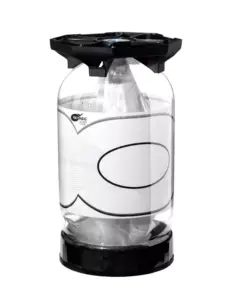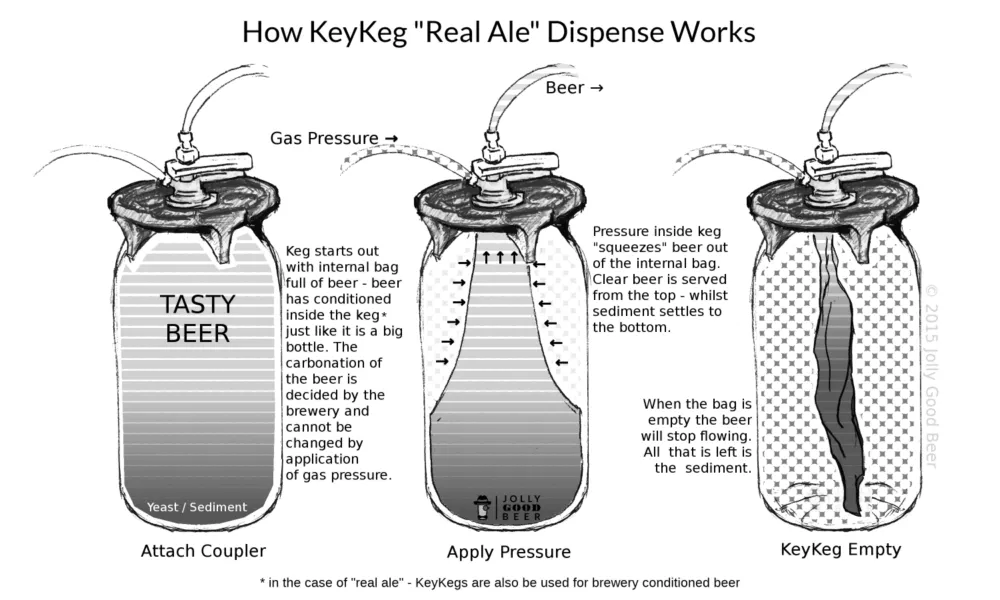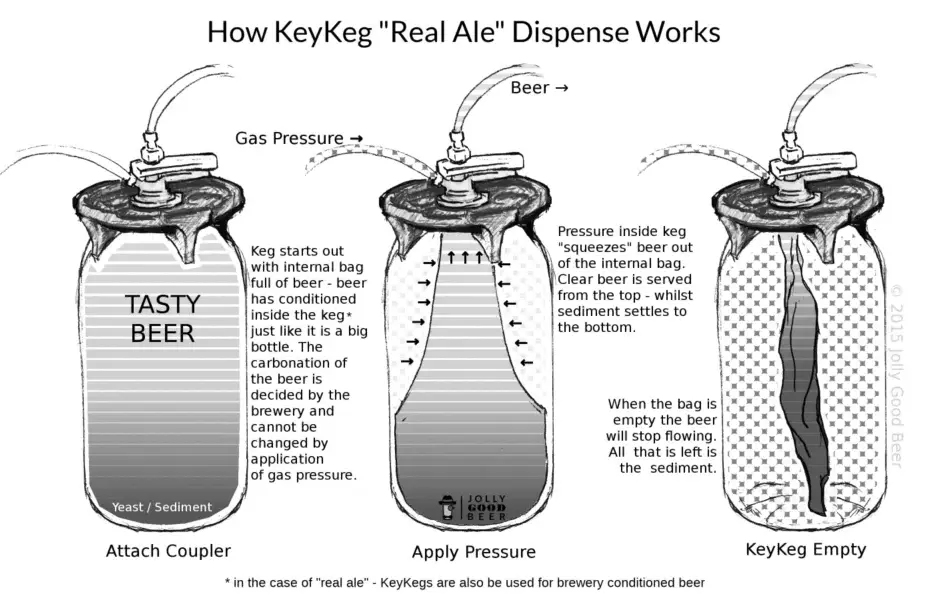 Wow… what a difference a few years makes. I joined CAMRA about 8 years ago – becoming an active member in the North Hertfordshire branch, and eventually branch cellarman for our beer festivals. Despite moving away to Cambridge I have still filled this technical role for the branch over the last few years. I was a software engineer back then, now I run my little beer distribution business – and most of my volume is kegged beer. I’m surprised I didn’t get barred from CAMRA already – spreading the keg love as I do!
Wow… what a difference a few years makes. I joined CAMRA about 8 years ago – becoming an active member in the North Hertfordshire branch, and eventually branch cellarman for our beer festivals. Despite moving away to Cambridge I have still filled this technical role for the branch over the last few years. I was a software engineer back then, now I run my little beer distribution business – and most of my volume is kegged beer. I’m surprised I didn’t get barred from CAMRA already – spreading the keg love as I do!
But what is really changing is CAMRA – stepping forward into the future. The CAMRA Technical Advisory Group (TAG) passed “KeyKeg” as being “real ale”-compatible some years ago, and in fact I had KeyKegs hooked up to handpumps at the Letchworth Garden City CAMRA beer festival in 2011. Last year support for KeyKeg was further reinforced by a CAMRA AGM motion being passed stating that CAMRA should support KeyKeg as a real ale format. (Much like supporting “real ale in a bottle” for example.)
Coming out of this the Manchester winter beer festival in January may well have been the first CAMRA beer festival to feature a dedicated British kegged beer bar. And KeyKegs have been seen at CAMRA fests here and there since the original TAG decision.
Now in my role supporting North Hertfordshire CAMRA beer festivals combined with my role promoting great beers (that I sell, obviously) I am being allowed to sponsor and run a “real ale in a keg” bar at the inaugural Stevenage Winter Beer & Cider Festival which kicks off this Thursday 4th of February. Easy to get to from Cambridge and London – if you’re into beer, and interested in this historic time in the history of CAMRA you should come along and marvel at there being a KEG bar at a CAMRA beer festival! And, of course, enjoy the awesome beers.
 KeyKeg allows breweries to produce well carbonated, pressure-dispensed beer that falls within the definition of “real ale” when unfiltered, unpasteurised, and “live” – because pressurised CO2 does not need to come into contact with the beer for dispense so it doesn’t suffer from the “extraneous CO2” problem. It isn’t quite so simple however – as filtered beer can be put in KeyKegs too. At the end of the day I judge a beer by how it tastes and don’t worry much about how “real” it is. But within the CAMRA context one must be a little more sensitive to the technicalities. So I have selected beers for the festival that I know to be “live” – and equivalent to the same beers as they would/could be packaged in cask. (There is a grey area around “tank conditioning” in this… but this grey area affects cask as well as keg so we base our judgement on the “live yeast” factor more than anything.) The beers I have selected to showcase KeyKeg are below – featuring mainly styles I think only, or at least best, work with the higher carbonation and cooler serve temperature of keg dispense. What do you think – a good intro to the concept of keg beers for the uninitiated I hope. If it is popular I may have some specials in reserve to sneak on too 😉
KeyKeg allows breweries to produce well carbonated, pressure-dispensed beer that falls within the definition of “real ale” when unfiltered, unpasteurised, and “live” – because pressurised CO2 does not need to come into contact with the beer for dispense so it doesn’t suffer from the “extraneous CO2” problem. It isn’t quite so simple however – as filtered beer can be put in KeyKegs too. At the end of the day I judge a beer by how it tastes and don’t worry much about how “real” it is. But within the CAMRA context one must be a little more sensitive to the technicalities. So I have selected beers for the festival that I know to be “live” – and equivalent to the same beers as they would/could be packaged in cask. (There is a grey area around “tank conditioning” in this… but this grey area affects cask as well as keg so we base our judgement on the “live yeast” factor more than anything.) The beers I have selected to showcase KeyKeg are below – featuring mainly styles I think only, or at least best, work with the higher carbonation and cooler serve temperature of keg dispense. What do you think – a good intro to the concept of keg beers for the uninitiated I hope. If it is popular I may have some specials in reserve to sneak on too 😉
| Brewery | Beer Name | ABV | Notes |
| Cloudwater | AUS Hopfen Weisse (Winter 2015/16) | 6.5% | Rich NZ/Aus Hopped Wheat Beer |
| Cloudwater | Dark Lager (Winter 2015/16) | 5.5% | Dark Yet Curiously Light & Hoppy |
| Cloudwater | IPA (Winter 2015/16) | 8.0% | Best Cloudwater IPA Yet |
| Hammerton | Islington Lager | 4.7% | Steam Lager |
| Pig & Porter | Elusive Pig II | 5.7% | Black IPA (Comet dry-hopped) |
| Pig & Porter | Honey Hill Wit | 5.0% | Honey Witbier |
| Siren | Calypso – Citra/Centennial/Equinox | 4.0% | Dry-Hopped Berlinerweisse |
| Siren | Pompelmocello | 6.0% | Sour Grapefruit IPA |
| Weird Beard | MAC Spreadsheet Ninja | 5.5% | Mosaic/Amarillo/Centennial Dry-Hop Pilsner |
| Weird Beard | Saison 14 | 6.0% | Dry Hopped Saison |
| Wild Weather | Khareef | 2.4% | Small Beer, Big Hops |
| Wild Weather | Message in a Potel | 7.5% | “Oversized Stout” |
| Wild Weather | Peach of a Weekend | 5.6% | Peachy Hoppy Sour |
I was also asked to write some text for the festival guide to explain KeyKeg, so I reproduce that here:
Real Ale in KeyKeg
Keg?! Why is this dirty word seen at a CAMRA beer festival? The history of CAMRA begins with keg – when breweries decided that cask was too expensive and difficult and keg was the future. But if expense is all that matters then a lot of other corners get cut – lower quality ingredients, cheap adjuncts used instead of malt – and the product is then filtered and pasteurised to give it a long shelf-life. This is the horror of insipid kegged beer that was taking over in the 70s and necessitated the founding of CAMRA to campaign for the survival of good beer. The big brewers gave keg a bad rap!
BUT – keg need not be this way. Many microbreweries today are experimenting with keg – especially for beers more suited to higher carbonation levels and cooler serve temperatures. This new wave of microbrewery kegged beer is unpasteurised and unfiltered, full flavoured live beer – much of it keg-conditioned and produced the same way as cask. There is still a problem however – by CAMRA definition CO2 top-pressure is not compatible with “real ale”. Even cask conditioned beer doesn’t qualify when CO2 aspirators are used – so a standard top-pressure keg certainly cannot.
Which is where the KeyKeg comes in. In a KeyKeg beer is contained within a “bag” inside the keg. And the gas pressure squeezes the bag to push the beer out. The gas can be CO2 – or simply compressed air – but has no contact with the beer inside the bag. We now have a type of kegged beer that meets the CAMRA definition of “real ale” – unpasteurised, unfiltered, live, and unsullied by “extraneous CO2”. Think of it being very much like “real ale in a bottle” – “real ale in a keg”! Approved by the CAMRA Technical Advisory Group (some years ago in fact) & there was a vote in favour of CAMRA supporting this form of real ale at the 2015 AGM – so this is all above board! KeyKegs have already been seen at various CAMRA festivals in the last few years, we had two at the last Letchworth Garden City festival – in that case vented to lower carbonation and served via handpump.
Do not worry about the future of proper cask ale however! Many beers work best in cask – you won’t find many breweries kegging bitters and best bitters for starters. The KeyKeg format suits zesty hop-forward pales, sours, wheats, saisons, lagers, and some stronger beers. However 1-way recyclable KeyKegs add to costs and a 30 litre KeyKeg has similar (if not greater) overheads to fill as a 41 litre cask. Which is one of the factors behind the higher pricing of these kegged beers. Cask ale is quite safe.

